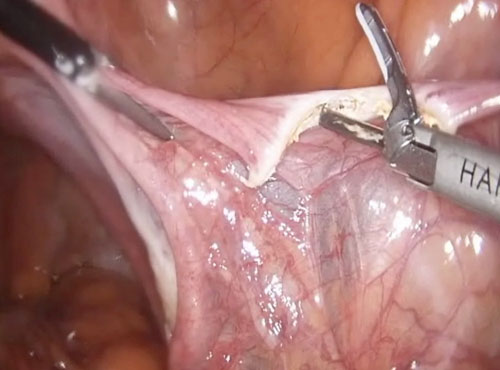Laparoscopic Hysterectomy
What is a hysterectomy?
Hysterectomy means the entire removal of the uterus or womb i.e. The organ responsible for regular menstrual bleeding. In some cases the tubes and ovaries are also removed.
Why do I need a hysterectomy?
A hysterectomy may be advised for various reasons, such as: Continued heavy or troublesome periods, fibroids or benign tumours of the uterus, prolapse, endometriosis and adenomyosis related symptoms and pre-cancerous or cancerous changes of the uterus or cervix. It is usually an elective procedure but may be life saving, especially with heavy bleeding or cancerous changes.
What are the alternatives?
Heavy bleeding can be treated with hormonal therapy (contraceptive pill or an intra uterine device IUD such as Mirena*) in the first instance, or by an endometrial ablation where the lining of the uterus is removed using an electrosurgical current. Both of these methods have a failure rate. The only definitive treatment for heavy bleeding is the removal of the uterus i.e. A hysterectomy. For many of the other ailments mentioned, hysterectomy is the best available method of treatment as well. Dr Reyftmann would be happy to outline the available options to allow you to make the best-informed decision.
What types of hysterectomy are there?
Abdominal hysterectomy:
Here, an 8-10 cm cut in the abdomen through which the uterus is removed. This method is suitable when the tubes and ovaries need to be removed as well, or if there is evidence of old scarring or adhesions in the pelvis after previous surgery or endometriosis. It is also the method of choice when the uterus is very bulky i.e. Has many fibroids.
Vaginal Hysterectomy:
This method is used when the uterus is small or there is prolapse. As it doesn't involve cuts in the abdomen; recovery is considerably faster and less painful.
Laparoscopic Hysterectomy:
The modern technique of keyhole surgery uses 3-4 small cuts in the abdomen to allow the use of a laparoscope and state-of-the-art operating equipment to change what would have been an abdominal hysterectomy to a vaginal hysterectomy.
According to the 2011-2012 Medicare data, one third of the hysterectomies performed in Australia are done vaginally, one third laparoscopically, and one third as an open surgery (which is still too high…).
Why use laparoscopy?
The laparoscopic approach allows an operation that would have been performed via the abdomen, to be converted to an operation performed via the vagina therefore providing all the benefits of that approach, including;
- Shorter hospital stays
- Less pain
- Faster recovery
- Faster return to work/normal activity

Is it safe?
All surgery carries risk. Studies have shown that in experienced hands the risk of major complications with laparoscopic hysterectomy is the same as an abdominal hysterectomy. These risks include: Those of anaesthesia, bleeding and the need for transfusion, infection, damage to surrounding organs and blood clots. Minor complications are fewer.
What happens before the operation?
You will have the opportunity to discuss any further questions with your doctor prior to your operation. You will be asked to sign a consent form, have some routine blood tests and be told about what to eat in the days before surgery. You should also stop taking aspirin or anti-inflammatory medications 7 days before the operation.
What will happen in hospital?
You will be admitted to hospital on the day of your operation. Your anaesthetist will see you to discuss the anaesthetic, any concerns you may have and to prescribe a premedication to help you relax before the operation. You will also receive medication to help empty the bowel. The operation itself takes 2 hours and you will spend an hour in the recovery ward before returning to your room.
How long is recovery?
The average stay after a laparoscopic hysterectomy is 1-2 days. Most patients require only oral pain relief after the first 24 hours and are eating and drinking normally within this period. This contrasts with abdominal hysterectomy where the usual stay is 6-7 days and normal eating /drinking patterns can take 2-3 days.
The average return to work/normal activity time is within approximately 3 weeks, compared to 6 weeks after abdominal hysterectomy. This includes driving and normal exercise patterns. A/Prof Reyftmann will answer any of these questions during postoperative visits both in hospital and later at the follow-up in the surgery.
Will my sex life be the same?
Some women do develop emotional reactions to the effects of surgery and the loss of their childbearing capacity. Others (the vast majority), feel finally liberated from constant heavy bleeding, the need for birth control, and uncomfortable prolapse and endometriosis symptoms. This often improves their state of mind and subsequently their libido or sex-drive.
We advise waiting until the check-up visit with your doctor before resuming sexual activity.
Women before the menopause should note that hysterectomy does not cause menopause unless the ovaries are removed at the same time. Women prior to the menopause will not undergo menopause because of their hysterectomy.
For those women who have had the ovaries removed with their hysterectomy might experience symptoms of the menopause including loss of sex drive, vaginal dryness and hot flushes. Your doctor can easily and readily treat these symptoms.
What do I do now?
A/Prof Reyftmann is an expert in laparoscopic reproductive surgery and is probably one of the most experienced in that field in the Illawarra. He would be happy to provide further information if desired. If you think these issues relate to you and you wish to organise a personal consultation please call
(02) 4227 6589 to make an appointment.
